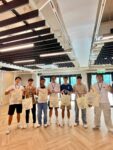Year 12 CAS – The Ark
CAS stands for Creativity, Action, and Service, and it is one of three essential elements that every student must complete to receive the IB Diploma. While not formally assessed, CAS provides opportunities for students to enhance their personal and interpersonal development through hands-on learning.
One of the components of CAS is a ‘CAS Project’, a collaborative series of student-initiated CAS experiences over several months engaging students in one or more CAS strands (creativity, activity, and service). Following the five CAS stages of Investigation, Preparation, Demonstration, Action, and Reflection, students can explore their passions whilst challenging themselves to initiate purposeful action around defined goals. The following months will bring a series of interviews where the STC Media Team interviews different students around school to highlight their CAS projects and initiatives.
This week, The Ark – consisting of members Jasmin Sin, Carmen Auyeung, Kazu Honda, Ethan Chan, and Paige Li – spoke to the STC Media Team about their CAS project. Concerned about climate change and its detrimental effects, they decided to use their sustainable clothing brand to raise awareness about the climate crisis.
Can you introduce The Ark? What is the purpose of your CAS project?
Recently, we started to recognise our responsibility as buyers and move towards becoming conscious consumers. However, the market in Hong Kong is currently dominated by fast fashion brands, making it difficult to find eco-friendly, sustainable alternatives for clothing. Therefore, we decided to do it ourselves! We all share a love for fashion, and it has always been an underlying interest to discover the science behind textiles production. Additionally, many of us hope to use this experience as budding entrepreneurs for future careers, and some of us have even discussed continuing the project after graduation.
As a symbol, ‘Noah’s Ark’ is known as one of preservation, redemption, and hope, which is why we called our brand ‘The Ark’. As a brand, we intend to incorporate this into our work with the primary purpose of improving awareness about climate change and climate action in Hong Kong. As a student-led initiative, we also hope to educate, inform and persuade our audience to become more aware of their eco-footprints and the impact their decisions have on the environment around us. That way, we can redefine the purpose of streetwear by appealing to clothing’s aesthetic value and its symbolic and ethical value.
What impact/outcome do you hope your CAS project will have on the school community?
We hope to raise awareness about the issue of climate change and actions to take against it through indirect advocacy on the school community. We plan to do this by designing hoodies and T-shirts using sustainable, eco-friendly materials and selling them to our schoolmates to spread awareness of how climate change negatively affects our future.
Were there any changes due to COVID-19? How have you adapted?
Due to all the challenges that the pandemic brought, we have somewhat changed the flow of our operations. We now have weekly online ZOOM meetings to keep ourselves up to date. We also plan to bring sewing machines home to work on our CAS project from home.
How does The Ark use art to depict and address social issues? Are there any difficulties in doing so?
We plan on designing t-shirts or hoodies. These products would include slogans and graphics that address the issue of climate change and sustainability.
It was challenging to come up with original designs. Criticising and judging different brands and their designs is easy, but having the creative drive and the ideas to create your own is a whole other level.
What are some particular pressing global issues In the context of Hong Kong that you hope to address with your brand?
As mentioned, The Ark is a sustainable fashion brand aimed to address and raise awareness about covert issues within our society. As residents of Hong Kong, we seek first to raise awareness about the prevalent social problems found within our community. We want to pay homage to the cement jungle we were born and raised in, which nurtured and shaped us into the young impressionable teens we are today.
Our chosen theme for the project is climate change; its significance outranks all its competitors. Why? We often dismiss climate change as less pressing than other social issues. But we can learn to be conscious consumers and love mother nature by shifting all focus onto the issue.
For one, the danger the endangered sea animals are in is hidden. We intend to use our voices and spread our message through the act of garment making. For example, Hong Kong-Chinese White Dolphins – an iconic symbol of Hong Kong – has dropped to a meagre population of 32 dolphins, as reported by the WWF. Our cumulative reckless acts: overfishing, water pollution, heavy marine traffic, and coastal development has led to this.
In particular, we have decided to become ambassadors of the Hong Kong Sharks Foundation. Our culture plays a massive role in the decline of sharks. Shark fin is tempting for fishers as sharks hold high monetary and cultural value. They are also widely used in a popular dish called shark fin soup, which is highly popular in Chinese culture. We intend to put a halt to this.
Teens hold a powerful place in society as they are the future pillar of the community. By aligning ourselves to the pillars of sustainability and activism, we can educate others and amplify the voices of the inferior.
Why is it essential that your brand is sustainable? What is the impact of fashion on the planet?
We made the deliberate decision to go sustainable from the very start. We understood the impact fast fashion has on our economy and environment. Corporate fashion companies continue to push through boundaries and release tens of new designs every week, attracting teens with low prices and trendy designs to cater to their audience. Old vintage pieces might be lucky and revitalised through thrifting.
Regardless, most clothing still goes to waste. That is why sustainable fashion is so essential; it talks about meeting today’s needs while ensuring that we meet the needs of future generations. Sustainable fashion is also about benefiting the people involved throughout the fashion supply chain – from farmers to consumers to everyone working in end-of-life facilities such as recycling factories. To tackle the existential threat of climate change, we need to start with the fashion industry addressing its unsustainable practices.
As a small fashion brand, we certainly will not make a significant impact, but we vow to do as much as possible to contribute and bring awareness to climate change. We want to make sure our brand can be ethical while celebrating our customers’ individuality and love of fashion. We also vow to do our utmost to address how the fashion industry is highly resource-intensive. For example, do you know that one cotton t-shirt takes 3000 litres of water to be made? Overall, we must take a step back and consider whether or not we need such items. It’s essential to know our impulsive buying decisions can bring irredeemable consequences to the world, especially the innocent animals who have to suffer because of us.
Who are your fashion inspirations?
The first person that comes to mind is Kanye West. As one of the most famous fashion figures in the entertainment industry today, his influence is undeniable. His confidence also sets him apart from others; it makes his persona and, in turn, his fashion sense unique.
We also took inspiration from Westside Gunn’s merchandise. We feel that his designs are worth taking inspiration from and that his graphics are of worthy note.
Written by: Grace Yeung
Edited by: Kadence Wong



